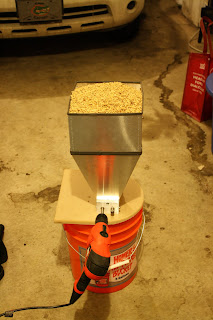
Happy 2 year anniversary! Its been two great years that have gone by very quickly, but as they say: "Time flies when you're having fun." I'm lucky to have meet Elise while we were young so that we have an even longer life together to have fun together.
On to the beer! As you can see in the pictures were were successful in wax dipping the tops of the bottles, and since we only made 3 gallons, we only have 13- 22oz bombers and 1- 12oz bottle. This beer was brewed on 1/3/2010 and bottled on 4/17/2010 and we were finally able to crack one open and taste it last night. We opened the 12oz bottle to try so we wouldn't have to drink 22oz's of 12.54% alcohol beer on a Monday night. Unfortunately, this bottle was not carbonated at all. When making high alcohol beers, the alcohol generated during fermentation by the yeast ultimately harms the yeast when the alcohol gets over ~10%. Since the BW (barley wine) finished at 12.54% we essentially murdered any yeast that would be available to bottle-carbonate so we added some new yeast at bottling. Hopefully, this non-carbonated bottle was just a fluke and the rest of the bottles are carbonated appropriately. Even though the beer was not carbonated, it still tasted delicious. It's very dangerous because its does not taste like 12.5% alcohol as the 1 year of aging has tremendously mellowed the alcohol flavor. The hop bitterness is still apparent and complements the malty-sweetness of the brew well. Overall, this is an almost too-easy drinking beer that is very strong and makes for a good sipping beer during these cold winter nights.
I wished we would have gotten around to waxing earlier (instead of yesterday) to keep oxygen out and potentially causing off-flavors as we plan to age this beer for several years. We have 13 bottles now, and are going to save 5 of those to taste 1 per year every year for the next 5 years. That will leave us with 8 bottles to enjoy at our leisure this year. Over the years the flavors will continue to increase in complexity as well as mellow harshers flavors in the beer, and the 6 year old should be amazing. In the top right picture you can see a wax blot that has been stamped with a "D." This was very hard to do as the hot wax did not want to stay on the round bottle long enough to cool and allow me to stamp it. We then made round stamps on wax paper and have been trying different ways to attach those to the bottles. Wax doesn't work very well as an adhesive when applied first to the bottle or the stamp, nor does super glue. Our next option will be a hot-glue gun, but if that doesn't work, then I don't think we will be able to attach the "D stamps" to the bottles.
We kind of dropped the ball with making another batch of this Anniversary Barley Wine with the holidays and everything that was going on, but we plan on making another small batch before school starts. We were initially undecided whether or not our Anniversary beer was going to be the same beer every year, or if we were going to change it up every year. After talking and tasting this beer though, we have decided that we are going to continue brewing this beer every year because it is so good and a proven recipe that makes good beer. Right now, I don't think we are going to scale the recipe up to 5 gallons because of the cost and the large volume of beer that it would make. This is not an everyday beer, and if we drink 2 bottles a month, it will take 4 months to drink all it, which I think is appropriate. This is a special beer not only because it commemorates a special day in our lives, but also because of the scarcity. If it were to be around all the time, then it wouldn't seem as special, so for now, 3 gallons it is. Next year we will have to figure out a way to differentiate between vintages of our BW by either dipping in a different color of wax or making some markings/labels on the bottles.












